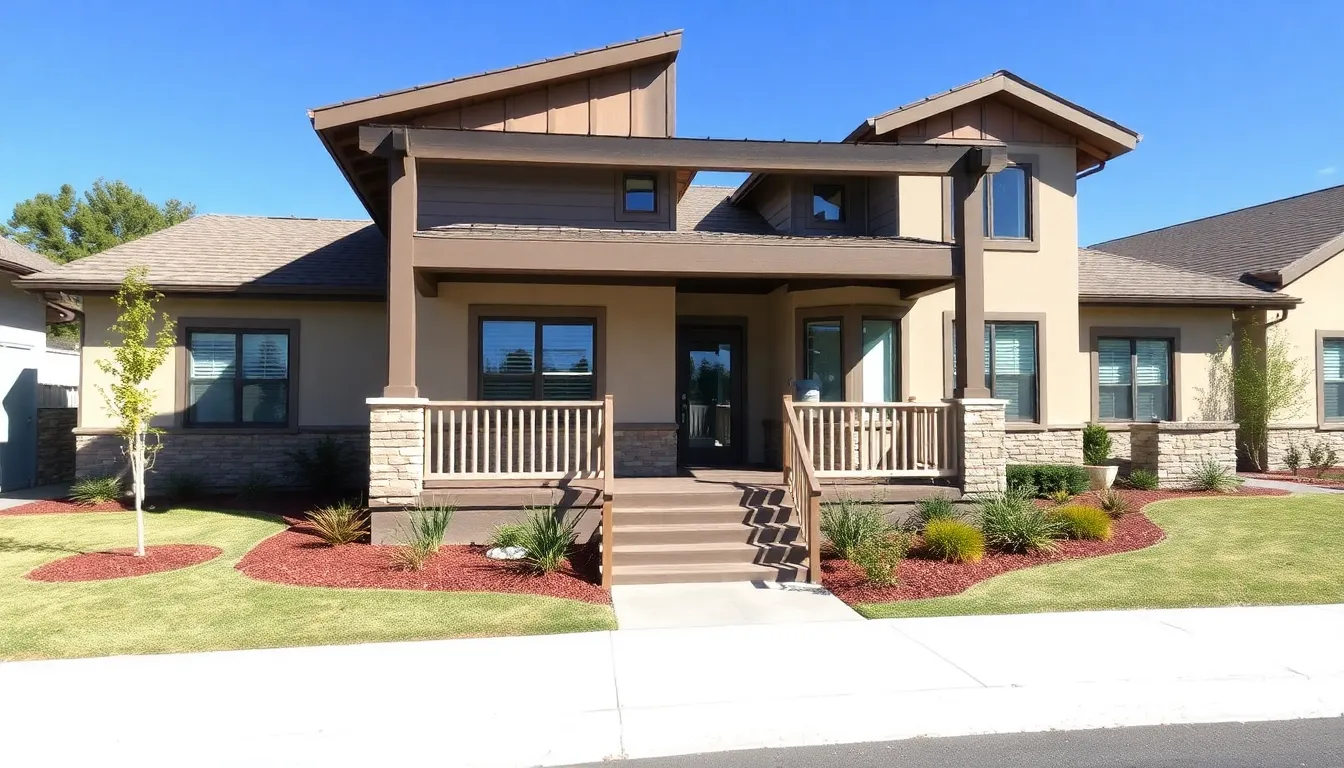Being a landlord can feel like juggling flaming torches while riding a unicycle. One wrong move and everything could go up in smoke. That’s where landlord insurance swoops in like a superhero, ready to save the day. With the right coverage, landlords can protect their investments from the unexpected chaos that tenants can bring.
But navigating the world of landlord insurance can be trickier than finding a needle in a haystack. From understanding policy options to deciphering the fine print, it’s easy to feel overwhelmed. Fear not! This guide will break down the essentials of landlord insurance, providing valuable advice to help landlords sleep soundly at night, knowing they’re covered—even if their tenants decide to host a spontaneous indoor trampoline party.
Table of Contents
ToggleUnderstanding Landlord Insurance
Landlord insurance protects property owners from various risks associated with renting out their properties. This coverage is vital for safeguarding investments against potential tenant-related issues.
What Is Landlord Insurance?
Landlord insurance is a specialized policy designed for property owners renting homes or commercial spaces. It typically covers property damage from events like fire, theft, or vandalism. Liability protection is also included, which assists if a tenant or visitor suffers an injury on the rental property. This insurance differs from standard homeowners insurance, as it specifically addresses the unique risks landlords face while managing rental properties.
Why Do You Need It?
Securing landlord insurance provides essential financial protection for property owners. It mitigates the risk of significant losses stemming from property damage or legal claims. Without proper coverage, landlords risk bearing the full financial burden of repairs, legal fees, or medical expenses. Additionally, the law requires liability coverage for landlords in certain jurisdictions, making it not only a smart choice but also a necessary one. This insurance fosters peace of mind, allowing landlords to focus on their rental business without constant worry about unforeseen incidents.
Types of Landlord Insurance Policies

Landlord insurance encompasses various policies tailored to protect rental property owners from distinct risks. Understanding these types helps landlords choose the right coverage.
Property Insurance
Property insurance offers protection against physical damage to rental properties. Events like fire, theft, and vandalism trigger coverage under this policy. Landlords benefit from compensation for repairs and replacement costs, ensuring financial stability after an incident. It’s common for property insurance to cover not just the structure, but also landlord-owned equipment and furnishings inside the rental, providing comprehensive protection.
Liability Insurance
Liability insurance covers injuries or damages occurring on the rental premises. This protection is crucial as it shields landlords from potential lawsuits related to accidents. If a tenant or visitor gets injured due to property neglect, liability insurance steps in to cover legal fees and medical expenses. The presence of adequate liability insurance meets legal requirements in many regions, reinforcing the importance of this coverage.
Rent Loss Coverage
Rent loss coverage offsets income lost due to property damage. When an event renders a rental uninhabitable, landlords suffer from lost rent. This type of insurance compensates for lost income during repair periods, providing financial relief. It’s particularly beneficial for longer repairs that can extend for months, ensuring landlords maintain their cash flow while their properties undergo necessary renovations.
Factors Influencing Your Landlord Insurance Premium
Several factors can impact landlord insurance premiums. Understanding these aspects helps landlords make informed decisions regarding their coverage.
Property Location
Property location significantly affects insurance costs. Areas with higher crime rates often lead to increased premiums, as risks for theft or vandalism rise. Additionally, regions prone to natural disasters like floods or earthquakes might incur higher insurance fees. Proximity to emergency services also plays a role; properties near fire stations may qualify for discounts. Landlords should assess the specific characteristics of their location as these elements directly influence overall premium rates.
Coverage Amount
Insurance coverage amount directly correlates to premium costs. Higher coverage limits typically result in increased premiums since more risk is covered. Landlords can opt for either actual cash value or replacement cost coverage, with the latter generally costing more. Choosing an appropriate amount of coverage protects landlords from financial losses. Assessing property value and potential rental income guides landlords in selecting the right coverage limits without overpaying.
Property Condition
Property condition directly impacts insurance premiums. Well-maintained properties often receive lower rates, as insurers view them as less risky. Features like updated plumbing, wiring, and roofs can reduce the likelihood of claims. Conversely, older or poorly maintained properties may incur higher premiums due to increased risks for damage or liability issues. Regular maintenance and timely repairs keep properties in optimal condition, helping landlords manage costs effectively.
Tips for Choosing the Right Landlord Insurance
Selecting the right landlord insurance policy involves careful consideration of several factors. Understanding personal coverage needs ensures the policy adequately protects property investments and liabilities.
Assessing Your Coverage Needs
Evaluating specific coverage requirements starts with identifying potential risks associated with rental properties. Consider location-based threats like natural disasters or crime rates. Important factors include the total property value and the expected rental income. Assessing present and future scenarios, such as vacancies or maintenance issues, helps determine appropriate coverage levels. Regularly reviewing these needs as market conditions change ensures optimal protection.
Comparing Insurance Providers
Researching multiple insurance providers encourages informed choices. Seeking referrals from other landlords provides insight into different experiences with specific companies. Key aspects to compare include premium costs, coverage offered, and customer service ratings. Investigating the financial stability of each provider helps assess their ability to pay claims. Requesting quotes and customizing policies according to individual needs enables better alignment with business goals.
Reading the Fine Print
Examining policy details is crucial to avoid unexpected gaps in coverage. Understanding the terms and conditions ensures clarity about what is included or excluded. Checking for coverage limits allows landlords to identify any inadequacies before claims arise. Noting the claims process and associated timelines can streamline future procedures. Thoroughly reviewing the policy before signing prevents costly misunderstandings later on.
Common Misconceptions About Landlord Insurance
Landlord insurance often faces various misconceptions that can mislead property owners. Understanding these myths helps landlords make informed decisions about their coverage.
It’s Too Expensive
Many landlords believe that insurance costs prohibitively high. Premiums actually vary based on several factors like location, property conditions, and coverage types. Landlords who maintain properties well often receive lower rates. Considering the potential financial losses from damages or lawsuits, paying for insurance becomes a wise investment. Comparing multiple quotes allows landlords to find policies that fit their budgets while providing adequate protection. Mistakenly, some skip coverage thinking it saves money, but the risk of unforeseen incidents can lead to far greater expenses.
All Policies Are the Same
There’s a common belief that all landlord insurance policies are identical, but this isn’t true. Different policies offer varying levels of coverage tailored to unique property needs. Some policies focus on property damage, while others provide comprehensive liability protection. Understanding specific risks tied to rental properties can help landlords select the best options. Reading the fine print reveals essential details that distinguish one policy from another. Recognizing differences in features ensures landlords choose coverage that aligns with their investment goals and risk tolerance.
Landlord insurance is more than just a safety net; it’s an essential tool for protecting investments and ensuring peace of mind. By understanding the various types of coverage available and the factors influencing premiums, landlords can make informed choices that best suit their needs.
Taking the time to compare policies and providers can lead to better coverage at competitive rates. It’s crucial for landlords to stay informed about their specific risks and to regularly evaluate their insurance needs as circumstances change. With the right landlord insurance in place, property owners can focus on managing their rental business without the constant worry of unexpected challenges.





